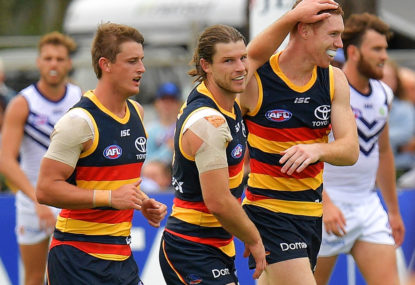'Sucked in beautifully': Neale, Lions goaded into two off-ball frees, then tries to win one himself
Things heating up in Canberra!

So with the 2018 season looming, it’s time for yet another season prediction. But rather than just taking a guess, I figured that I would try to find a more objective, mathematical approach.
I spent last year coming up with my own rating system, so now is the time to put it to work. Introducing the Deemed Measure of Expectation and Performance (DMXP). It could also be the Darren M Expectation and Performance rating, but that’s just a coincidence!
There are two basic components to this: expectation and performance.
The Performance component measures the teams’ strengths based on actual game results. Good wins count more, beating a good team by 12 points will usually yield better results than the top team flogging the bottom team by 40.
The Expectation component tries to predict final scores for games based on the performance ratings of each team, compared to the ranking of the opposition. This is then translated into traditional footy tips.
If you really care, you can see the details of how the ratings are calculated.
Because the predicted score uses the team ratings as its basis, obviously, the highest rated team will overwhelmingly be tipped to win. Adjustments do apply for interstate trips and short breaks, but in the main, it will fail to tip upsets.
I will probably revisit the expectation component sometime later on, to take historical results and actual venues into account, but that’s a while off.
As 2018 is the first live test of the expectation rating, it will be interesting to see how it holds up throughout the year.
So now, where does the DMXP rating place each team at the end of the year? Results are based on the hypothetical ladder after 23 rounds.
1. Adelaide (20 wins 124%; DMXP Rating 1st place +16.187)
20 wins is a very high result, and is directly caused by the rating system. The top-rated team will naturally be predicted to beat almost every other team.
2. Sydney (20 wins 121%; DMXP 2nd +15.376)
While the top team winning 20 times is certainly feasible, two teams on 20 is highly unlikely. The overall strength of Sydney is attributed to their strong form from 2017.
3. Port Adelaide (19 wins 121%; DMXP 3rd +13.616)
Certainly a lot of wins at the top. Port Adelaide had a formidable percentage last year, which probably inflates their rating somewhat.
4. Geelong (18 wins 113%; DMXP 4th +11.208)
For fourth place, 18 is a heck of a lot of wins. Geelong look set to continue on their winning ways.
5. Richmond (17 wins 110%; DMXP 5th +10.174)
The Premiers are still in the thick of it winning more games than any team this year.
6. GWS (14 wins 104%; DMXP 6th +7.195)
GWS are now back in the pack. Having lost a lot of experience (second most overall) and, with 2 draws and close results, their pre-season rating is not that high.
7. Melbourne (10 wins 98%; DMXP 8th +2.416)
Melbourne’s stats continue to remarkably show average and almost break-even results. Between sixth and seventh, we see a big gap in overall wins for the season.
8. West Coat (10 wins 96%; DMXP 10th +0.985)
West Coast squeak in behind Melbourne this year. Remarkably, they are only the 10th best team according to DMXP. Of course, they have lost the most experience over the break.
9. Western Bulldogs (10 wins 96%; DMXP 12th -0.455)
The Bulldogs miss the eight by 0.2% and their overall DMXP is the first negative score.
10. Essendon (9 wins 100%; DMXP 7th +2.625)
Essendon just cannot scrape enough wins together. Their percentage is better than the three teams above them, and they rank higher in DMXP.
11. Brisbane Lions (9 wins 88%; DMXP 14th -6.048)
Yes, that’s right. Brisbane Lions will win as many games as Essendon. However, their rating shows the true story. They are still a bottom six team.
12. Fremantle (9 wins 86%; DMXP 15th -7.078)
Just as they seemed to through 2017, Freo is another team playing above their average. However, their poker face is showing in their lowly DMXP rating.
13. Collingwood (8 wins 99%; DMXP 11th +0.864)
Like Essendon, the DMXP is better than the ladder, based on the number of wins it can find. They appear to be a better team than 13th.
14. St Kilda (8 wins 97%; DMXP 9th +1.413)
In reality, eight wins should be enough to stay in touch with the eight deep into the season. This is matched by their 9th place in DMXP.
15. Hawthorn (6 wins 93%; DMXP 13th -1.186)
Hawthorn’s low rating is based mainly on some bad results last year. They actually gain a fraction of experience points, so they might be able to bounce back from here.
16. Carlton (4 wins 88%; DMXP 17th -7.463)
Nothing much changes here in terms of the numbers. Let’s move along.
17 Gold Coast (4 wins 83%; DMXP 18th -11.733)
Suprised to see that Gold Coast are not collecting the spoon. Yeah, me too. They are, however, the worst team by a long way according to DMXP.
18 North Melbourne (3 wins 86%; DMXP 16th +7.102)
North Melbourne have one fewer win, claiming the spoon. Their rating indicates they are better than Carlton and Gold Coast though.
While there are a few anomalies, overall the results appear quite sound. Of course, we shall revisit this throughout the year to see how good my predictions are traveling.